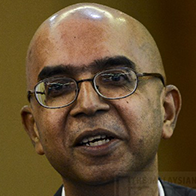What's judicial activism? What's good about it? What's not? Do we want it?
 In my last article, I mentioned the three key features of a democracy, namely the Executive, the Legislature and the Judiciary.
In my last article, I mentioned the three key features of a democracy, namely the Executive, the Legislature and the Judiciary.
I said that in the 2014 general election in India, which Narendra Modi's BJP party won, one of three winning candidates had criminal cases pending against them, and that the "criminalisation of the legislature" began in the 70's, thus the judiciary stepped up to fill the moral gap.
In the wake of the Attorney-General Tan Sri Mohamed Apandi Ali's decision not to prosecute Prime Minister Datuk Seri Najib Razak despite alleged recommendations by the Malaysian Anti-Corruption Commission (MACC), I wondered whether our judges would review the A-G's decision.
Through judicial review judges can negate actions taken by a public authority; they can even tell the legislature to revoke laws which they think contravene constitutional provisions.
In my earlier article I pointed to evidence that our judiciary reads the constitution narrowly.
In this article I will point to a judiciary which reads the constitution broadly, and practices judicial activism, which means the judiciary acts like the political branches of government.
You may know that New Delhi is the world's most polluted city, though over the past two decades many actions have been taken to reduce air pollution in Delhi.
You may not know that the "power" which ordered the authorities to take such actions is the Supreme Court of India.
The reason buses in Delhi now run on natural gas is the judiciary.
In October 2001, the Supreme Court ordered authorities to ensure that all buses in Delhi run on natural gas by the end of 2001. The judges based their order on the constitutional guarantee of health to Indian citizens!
Indian judges promote public interest litigation. They have a broad view of locus standi, which is legalese for the person with a right to be heard in court. I will let Justice K.G. Balakrishnan, Chief Justice of India, explain locus standi.
In a 2009 lecture he gave at the Trinity College in Dublin, Ireland, Justice Balakrishnan said the following:
"The foremost change (the Court made) came in the form of the dilution of the requirement of locus standi for initiating proceedings. Since the intent was to improve access to justice for those who were otherwise too poor to move the courts or were unaware of their legal entitlements, the Court allowed actions to be brought on their behalf by social activists and lawyers.
"In numerous instances, the Court took suo moto cognizance ('independent judicial action') of matters involving the abuse of prisoners, bonded labourers and inmates of mental institutions, through letters addressed to sitting judges."
Now, anyone could petition a High Court or the Supreme Court for justice on behalf of others!
If higher court judges only have before them allegations – without evidence sifted by a lower court – how can they decide on the case?
Conventional hearings are based upon each adversary presenting his or her side of the case before a judge who dispassionately listens, evaluates and decides the case.
So, to activate "epistolary jurisdiction," the judges had to innovate.
In a 1986 lecture he gave in the University of Wisconsin law school, Justice P.N. Bhagwati, also a former Chief Justice of India, explained the process as follows:
"We made a departure from the adversary system and we have started appointing commissioners for the purpose of investigating and making reports to the court. Copies of their reports are given to both sides and they are asked to make their submissions, file their affidavits and the court will decide.
"Next we faced the problem of what remedies to be given. The ordinary remedy of Writs of Certiorari and Prohibition would not help. So we developed a wide ranging repertoire of remedies which would help to solve the problems of these people.
"Finally, we needed to develop monitoring mechanisms for the purpose of seeing that our orders are implemented."
In his lecture, Justice Balakrishnan included a vast array of cases heard using the new process.
Judicial activism in India is not a flash in the pan, instead it is the new normal.
Judicial activism is not without its critics. Critics argue that in a democracy, the involvement of judges in policy-making is encroachment into the space reserved for the political branches of government.
For example, in December 2015, the Supreme Court of India banned registration of high capacity diesel SUVs in Delhi till March 31, 2016, imposed environmental taxes on diesel vehicles bringing goods into Delhi, prohibited "passing through Delhi" of commercial vehicles bound elsewhere, etc.
If the results of those actions aren't favourable, voters can't go to the ballot box and penalise those who made the decisions.
How do Malaysia's judges view locus standi and public interest litigation? Should Malaysia's judges be more like India's judges? – February 11, 2016.
* This is the personal opinion of the writer, organisation or publication and does not necessarily represent the views of The Malaysian Insider.


Comments
Please refrain from nicknames or comments of a racist, sexist, personal, vulgar or derogatory nature, or you may risk being blocked from commenting in our website. We encourage commenters to use their real names as their username. As comments are moderated, they may not appear immediately or even on the same day you posted them. We also reserve the right to delete off-topic comments